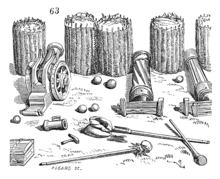Entrenchment

Jumping cages were cylindrical braids made of willow rods and filled with earthwork. In the military , the bulwarks have been used since the introduction of gunpowder , especially in the fortress war, to build field fortifications . They were mainly used to strengthen parapets , saplings and shelters when building positions .
As a rule, the bulwarks had no bottom. The dimensions were different, but at least in the German Empire in the second half of the 19th century a standardization of 1.30 m in height and 0.60 m in diameter was introduced. Because the bulwarks were made of yielding material filled with earth or sand, they were better suited to absorb the effects of enemy projectiles. In the trenches, the sappers could simply move the light baskets and fill them with earth on site. In addition, the bulwarks were easy to improvise and extremely cheap to manufacture.
The smallest kind of bulwark baskets were the sapphire baskets with a height of approx. 70 cm and a diameter of 40 cm . Other baskets had a height of about one meter and a diameter of 60–70 cm and were used to fasten the parapets. If the baskets were even higher and wider, they were primarily used to protect artillery positions and were called battery baskets .
In some parts of Germany these baskets were also used to build dikes or dams. So-called entrenchment bridges were built from them . Today such building materials are known as gabions . They usually no longer consist of willow branches, but of a metal cage or wire.
The military version (Hesco bastions) of about 1.20 m in diameter are used by modern armed forces, for example the US Army , to build military fortifications.
The German Armed Forces also use this type of field fortification to secure their camps, for example. B. in Afghanistan. Pioneering devices such as wheel loaders and caterpillars can erect a section of wall from two side by side and a basket on top in 20 minutes. It would take 10 soldiers about 7 hours to produce a piece of wall of the same length made from approx. 1500 sandbags . Protective walls built from Hescos are more durable today than in the past and can be quickly erected, dismantled or repaired.
In principle, the protective properties are used like gabions.
The German combat units of Task Force Kunduz III ( training and protection battalion ), which operated in 2011 in the Afghan troubled district Char Darah , have converted their combat vehicles, the Marder armored personnel carriers, into rolling fortresses with the help of bulwarks . They cut Hesco grids to size, tied them tightly to the armor, filled them with sandbags and covered them with jute fabric, which made it possible to create rifle rests, covers and additional storage space.
literature
- Heinrich August Pierer : Universal encyclopedia of the present and the past . 4th edition, Altenburg 1857-1865, Volume 15, pp. 90-91.
- Bernhard von Poten : Concise dictionary of the entire military science. Velhagen & Klasing, Bielefeld and Leipzig 1880, p. 295.
Individual evidence
- ↑ Marcel Bohnert & Andy Neumann: Panzergrenadiers in combat in Afghanistan , in: Freundeskreis der Panzergrenadiertruppe (ed.): Panzergrenadiers. A class of troops through the ages , Munster et al. 2016, ISBN 3-933802-35-0 , p. 53f.

